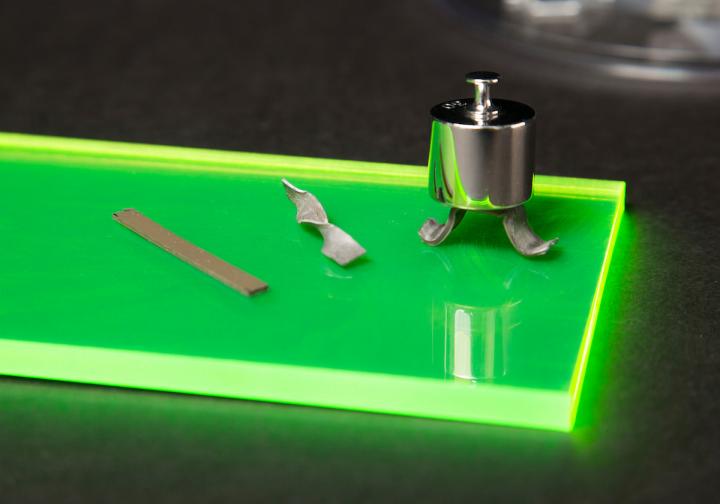Engineers develop smart material that changes stiffness when twisted or bent

Examples of the new smart material, left to right: A flexible strip; a flexible strip that stiffened when twisted; a flexible strip transformed into a hard composite that can hold up a weight. Credit: Christopher Gannon/Iowa State University
Stress a muscle and it gets stronger. Mechanically stress the rubbery material – say with a twist or a bend – and the material automatically stiffens by up to 300 percent, the engineers said. In lab tests, mechanical stresses transformed a flexible strip of the material into a hard composite that can support 50 times its own weight.
This new composite material doesn't need outside energy sources such as heat, light or electricity to change its properties. And it could be used in a variety of ways, including applications in medicine and industry.
The material is described in a paper recently published online by the scientific journal Materials Horizons. The lead authors are Martin Thuo and Michael Bartlett, Iowa State assistant professors of materials science and engineering. First authors are Boyce Chang and Ravi Tutika, Iowa State doctoral students in materials science and engineering. Chang is also a student associate of the U.S. Department of Energy's Ames Laboratory.
Iowa State startup funds for Thuo and Bartlett supported development of the new material. Thuo's Black & Veatch faculty fellowship also helped support the project.
Development of the material combined Thuo's expertise in micro-sized, liquid-metal particles with Bartlett's expertise in soft materials such as rubbers, plastics and gels.
It's a powerful combination.
The researchers found a simple, low-cost way to produce particles of undercooled metal – that's metal that remains liquid even below its melting temperature. The tiny particles (they're just 1 to 20 millionths of a meter across) are created by exposing droplets of melted metal to oxygen, creating an oxidation layer that coats the droplets and stops the liquid metal from turning solid. They also found ways to mix the liquid-metal particles with a rubbery elastomer material without breaking the particles.
When this hybrid material is subject to mechanical stresses – pushing, twisting, bending, squeezing – the liquid-metal particles break open. The liquid metal flows out of the oxide shell, fuses together and solidifies.
“You can squeeze these particles just like a balloon,” Thuo said. “When they pop, that's what makes the metal flow and solidify.”
The result, Bartlett said, is a “metal mesh that forms inside the material.”
Thuo and Bartlett said the popping point can be tuned to make the liquid metal flow after varying amounts of mechanical stress. Tuning could involve changing the metal used, changing the particle sizes or changing the soft material.
In this case, the liquid-metal particles contain Field's metal, an alloy of bismuth, indium and tin. But Thuo said other metals will work, too.
“The idea is that no matter what metal you can get to undercool, you'll get the same behavior,” he said.
The engineers say the new material could be used in medicine to support delicate tissues or in industry to protect valuable sensors. There could also be uses in soft and bio-inspired robotics or reconfigurable and wearable electronics. The Iowa State University Research Foundation is working to patent the material and it is available for licensing.
“A device with this material can flex up to a certain amount of load,” Bartlett said. “But if you continue stressing it, the elastomer will stiffen and stop or slow down these forces.”
And that, the engineers say, is how they're putting some muscle in their new smart material.
###
The research team
Additional co-authors of the Materials Horizons paper describing smart composites that change stiffness under mechanical stress are:
Joel Cutinho, a former Iowa State graduate student who now works for Nanolab Technologies; Stephanie Oyola-Reynoso, a former Iowa State graduate student who's now a postdoctoral research associate at Harvard University in Massachusetts; and Jiahao Chen, a former Iowa State graduate student who's now a postdoctoral research associate at Northwestern University in Illinois.
Read the paper
Mechanically triggered composite stiffness tuning through thermodynamic relaxation (ST3R), http://pubs.
Media Contact
All latest news from the category: Materials Sciences
Materials management deals with the research, development, manufacturing and processing of raw and industrial materials. Key aspects here are biological and medical issues, which play an increasingly important role in this field.
innovations-report offers in-depth articles related to the development and application of materials and the structure and properties of new materials.
Newest articles

Properties of new materials for microchips
… can now be measured well. Reseachers of Delft University of Technology demonstrated measuring performance properties of ultrathin silicon membranes. Making ever smaller and more powerful chips requires new ultrathin…

Floating solar’s potential
… to support sustainable development by addressing climate, water, and energy goals holistically. A new study published this week in Nature Energy raises the potential for floating solar photovoltaics (FPV)…

Skyrmions move at record speeds
… a step towards the computing of the future. An international research team led by scientists from the CNRS1 has discovered that the magnetic nanobubbles2 known as skyrmions can be…





















